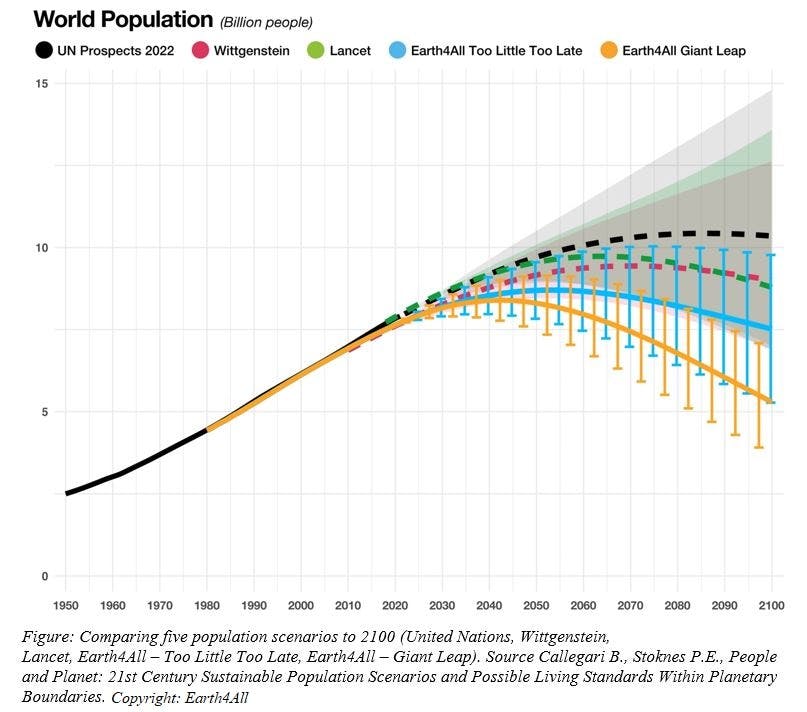An easy way to start a long, heated debate is to mention global population. Thomas Malthus famously ignited furious arguments in the nineteenth century when he warned that, absent fertility-control policies, exponential population growth would outpace improvements in agriculture and cause recurrent bouts of famine and pestilence. Industrialisation would postpone the crisis, but not forever.
These arguments were still raging in the 1960s, when Paul and Anne Ehrlich added fuel to the fire with their bestseller, The Population Bomb. Their fears were reasonable, given the data. By 1975, the global population doubled to four billion – in just under 50 years. It has just doubled again, reaching eight billion last November. This raises a new question: Will the population double again to 16 billion?
The answer is a resounding no. In fact, the global population will not get anywhere close to that level, owing to a paradigm shift in demographics over the past 50 years. The population growth rate peaked in the 1960s and has been falling steadily ever since. Women around the world are choosing to have fewer children, and the global average fertility rate is now just above two children per woman.
Of course, this figure masks large geographic disparities. The number of children per woman is below two in places like Germany and Japan, but much higher in most low-income countries, especially fragile states. Still, the United Nations estimates that the global population could peak at 10 to 11 billion people this century, before starting to decline slowly. That is a huge number of mouths to feed, but it is nowhere near 16 billion.
Moreover, our own analysis in a new report, People and Planet: 21st Century Sustainable Population Scenarios and Possible Living Standards Within Planetary Boundaries, produced for the Global Challenges Foundation in Stockholm, concludes that the global population could peak at a much lower level – around nine billion – by mid-century. And if the world invests more in economic development, education, and health, the global population could fall to levels at which everyone on Earth can have sustainable access to clean energy, shelter, food, and water. The bomb will have been defused, allowing everyone to live a good life within planetary boundaries. This should be cause for celebration.
Our projections come from a new system dynamics model, Earth4All, which allows us to explore two economic and population scenarios this century. In the first scenario, the world economy continues along a path similar to the one followed during the last 50 years, many of the poorest countries eventually break free from extreme poverty, and the global population peaks at 8.8 billion in the middle of the century before declining to 7.3 billion in 2100.
In the second scenario, which we call the “Giant Leap,” the global population peaks at 8.5 billion by around 2040 and declines to just six billion by the end of the century. This would require unprecedented investments in poverty alleviation and human capital, along with extraordinary policy turnarounds on food and energy security, inequality, and gender equity. In this potential future, extreme poverty would be eliminated within a generation (by 2060), with a marked impact on global population trends.

The demographic projections in Earth4All’s new report, People and Planet, are significantly lower than existing projections, which is due largely to different variables regarding female educational attaimnet. Source: Beniamino Callegari/ Earth4All
Mainstream demographic projections often struggle to connect population growth to economic development. Yet we know that rapid economic development in low-income countries has a huge impact on fertility rates. Fertility rates fall as girls gain access to education and as women become more economically empowered through access to paid employment and better health-care and family-planning methods. When we incorporated these factors into our projections, population growth slowed dramatically.
But our findings come with a big caveat. To achieve the Great Leap, governments in low-income countries must commit fully to pursuing economic development based on large investments in education, rather than economic growth driven solely by natural-resources extraction.
Moreover, while defusing the population bomb may be necessary for reducing the risk of future civilisational collapse, it is not sufficient. When we investigated the connection between population and planetary boundaries, we found that – contrary to popular myth – population size is not the primary reason that humanity is breaching these boundaries (reflected in problems like climate change). Rather, the main driver is consumption by the richest 10 per cent – a cohort that has an extremely large material footprint.
Humanity’s big problem is luxury carbon and biosphere consumption, not population. The places where population is rising fastest have extremely small environmental footprints per person, relative to countries that reached peak population many decades ago. If resources were distributed more fairly, today’s global population would already enjoy living conditions exceeding the UN’s minimum level, and without the need for significant changes in developmental trends.
People and Planet provides a hopeful outlook on global population. Our findings challenge the common misconception that population growth is the main cause of exceeding planetary boundaries. In reality, the world’s wealthiest people are the ones driving us toward the cliff.
Through systemic economic change, we could still provide a good life for everyone within planetary boundaries. We hope our report will lead policymakers to re-examine the impact of consumption patterns and prioritise equitable distribution over economic growth for its own sake.
Beniamino Callegari, an associate professor at Kristiania University College, is a member of the Earth4All modelling team.
Per Espen Stoknes, Project Lead of Earth4All, is Director of the Center for Sustainability and Energy at the BI Norwegian Business School.Copyright: Project Syndicate, 2023.www.project-syndicate.org



















